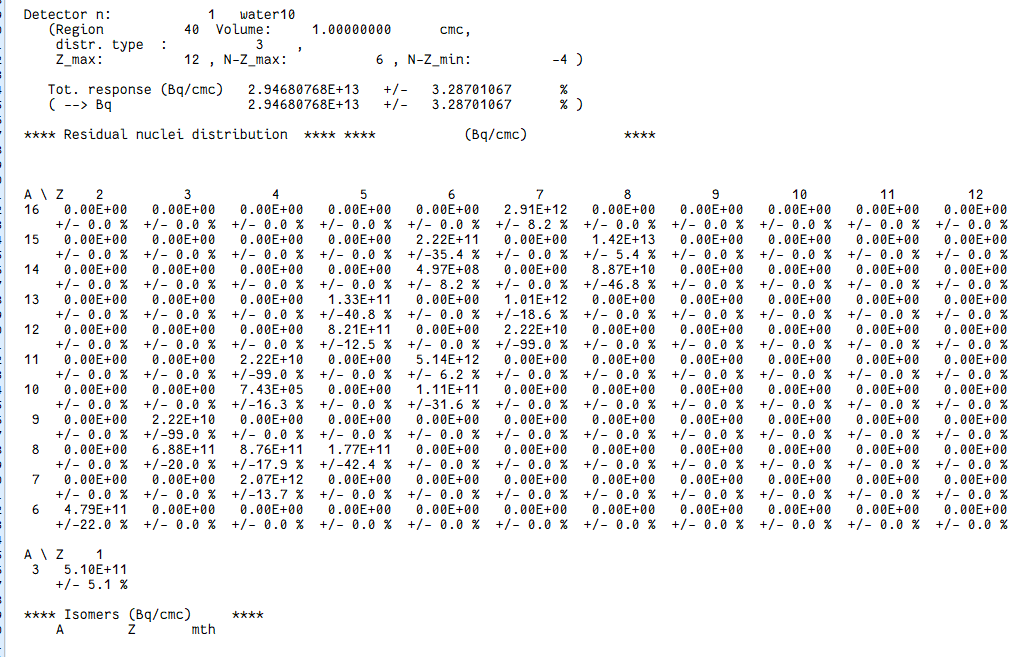I would like to know what is the difference between a usrsuwev.f file and a usrsuw.f file? What is the difference in the results of the data they get? They will get two sum files separately, can the units in these two files be converted to each other? (BQ/CMC) and (Nuclei / CMC / PR)
usrsuw.f (41.6 KB)
usrsuwev.f (73.2 KB)
Dear @dinggz ,
many thanks for your question.
As you may know, the decay of residual nuclei can be performed by FLUKA in the same run (using the commands DCYSCORE, DCYTIMES and IRRPROFIle). The scoring of residual activity in a region can be done with a RESNUCLE card to which you associate, via DCYSCORE, a cooling time that you should have previously defined via DCYTIMES: in this case the output units will be Bq or Bq/cm3 if you have provided the region volume for normalization. If you do not associate a cooling time to RESNUCLE, you are effectively scoring a nuclide yield and the results will be in nuclides/primary or nuclides/cm3/primary always depending on the normalization factor you have entered.
Now, once you have run your simulation and all your cycles have finished, you would most naturally process (i.e. merge) the results. USRSUW is the program that is used for the read-out and estimation of the standard deviation of RESNUCLE estimators. You would use it regardless of what you are scoring with RENUCLE (activities or yield). Note that you don’t have to worry about this aspect if you are using Flair since USRSUW is automatically called when processing the output from RESNUCLE.
Instead, the USRSWEV program can be used in the remote cases in which you want to manually perform the time-evolution off-line, thus going from a nuclide yield in nuclides/primary obtained from a RESNUCLE output to activities in Bq. You cannot go back from activities to yields. Note that it is a command-line program to which you would have to manually provide the irradiation periods and the cooling times. From personal experience, I find it way more convenient to define your irradiation profile and cooling times in the FLUKA input file and have the activities estimated in one single run.
If there are aspects that are still not clear, you can always refer to the lecture on radiation protection calculations from the latest course.
Best,
Davide
Thank you very much for your answer, I still have a question for you, the sum file I got with usrsuwev recorded the activity concentration of the nuclide (Bq/cmc), but the data obtained by multiplying this value by volume should be Bq, but it is not the same as the value in the tab file obtained by usrsuw, can you tell me why? …
Dear @dinggz ,
could you please provide the input file, the irradiation profile and cooling times used? In this way it will be easier to assist you.
Best,
Davide
Thank you for your patient answer. I have understood the above questions, but some new questions have emerged as follows:
- Why are the types of nuclides recorded in sum and res files generated by usrsuwev less than those recorded by tab? Even the types of sum and res file nuclides in usrsuwev are different.
- Why does the tritium nuclide in tab not correspond to the tritium nuclide in res file generated by usrsuwev?
Looking forward to your reply.
(The following are sum, tab, res files in order)
Dear @dinggz,
thanks for your reply. Although it is a bit difficult to debug without the input file, I see that you are for sure comparing values from two different regions. In the first screenshot I see Region 40 (water10), in the last one I read Region 38 (water8).
Best,
Davide
Thank you for your reply. I’m sorry that there are problems with the pictures I gave, which should all be water10. Here I give their original files, and I would like to express my thanks to you again.
test15_23_tab.lis (74.7 KB)
testwater2_res.lis (18.3 KB)
testwater2_sum.lis (38.1 KB)
Dear FLUKA experts,
This is the tab.lis file in flair and the res.lis file generated by usrsuwev (both conditions are exactly the same), what’s the difference between them? Why are there more nuclides in tab files than res files?
Thank you!
test15_24_tab.lis (236.1 KB)
testwet2_res.lis (39.7 KB)
Dear @dinggz,
thanks again for your question and providing the files.
I will have a look as soon as possible and come back to you.
Best,
Davide
Dear @dinggz,
thanks for your patience. The *res.lis file indeed contains only a subset of the nuclide activities and is meant to provide a summary of the top contributors. The program usrsuwev writes to the *res.lis file only the nuclides whose activity is greater than 1/1000 of the total activity: this threshold is hard coded. The *sum.lis file that is produced by usrsuwev contains however the full inventory (activities below the code “zero” which is 1e-30).
Best,
Davide


